Pangong Lake, also known as Pangong Tso, is one of the most magical places you can visit in the Indian Himalayas in Ladakh. You are standing in front of a lake so calm, so colorful, and so quiet that it feels like another world. Surrounded by tall mountains, with water that changes color during the day, this lake is truly a hidden gem.
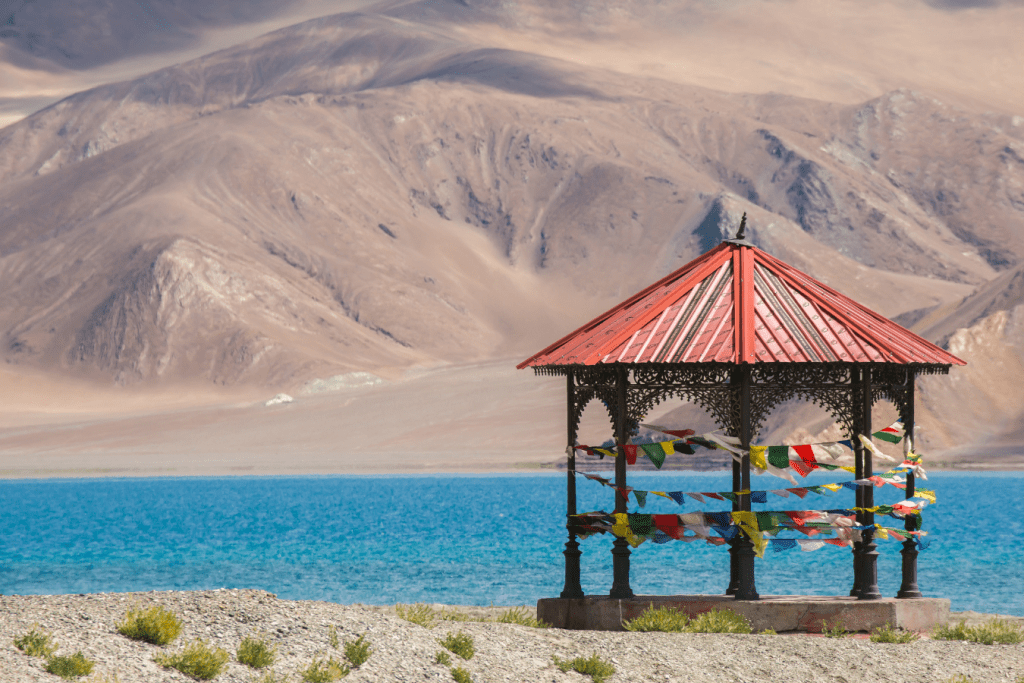
But Pangong Lake is not just beautiful—it’s also very special. It is a high-altitude saltwater lake that freezes completely in winter, even though salty water usually doesn’t freeze easily. It’s also home to rare birds, no fish, and is one of the most peaceful spots on Earth. Whether you are looking for adventure, photography, or just peace and quiet, Pangong Lake will leave you speechless.
Where exactly is Pangong Lake?
Pangong Lake is located in the Union Territory of Ladakh, in the northern part of India. The lake is so large that it stretches all the way into Tibet (China). It sits high up in the mountains at an altitude of 4,225 meters (13,862 feet) above sea level.
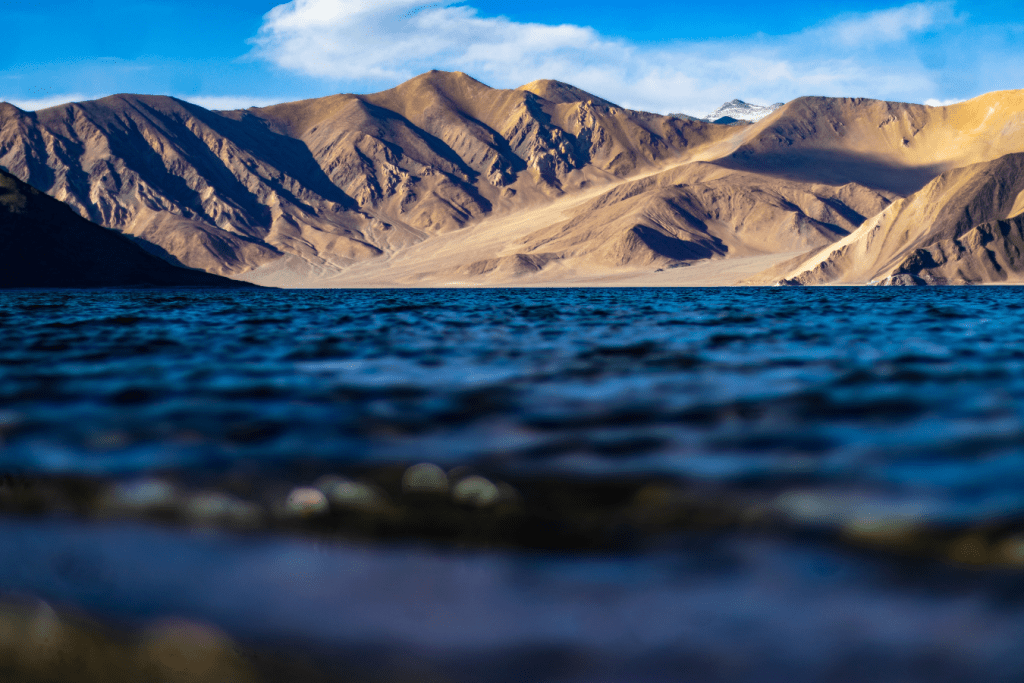
The lake is very long—about 134 kilometers—and at its widest point, it is about 5 kilometers wide. Because of its unique location, the lake is shared by three regions:
- 40% of the lake is in Ladakh, India
- 50% is in Tibet, under Chinese control
- 10% is in an area that is disputed, but currently controlled by China
Another interesting fact is that Pangong is an endorheic lake, which means it doesn’t connect to any ocean or sea. The water stays inside the lake, with no rivers flowing in or out. And even though it is salty, the lake freezes completely in winter, turning into a huge mirror of ice surrounded by snow-covered peaks.
A Pangong Lake That Changes Color with Your Mood
Pangong Lake is special not only because of its beauty, but also because it changes color throughout the day. Sometimes the water looks deep blue, then green, and later it may turn light turquoise or even golden. This makes the lake feel different every time you look at it.
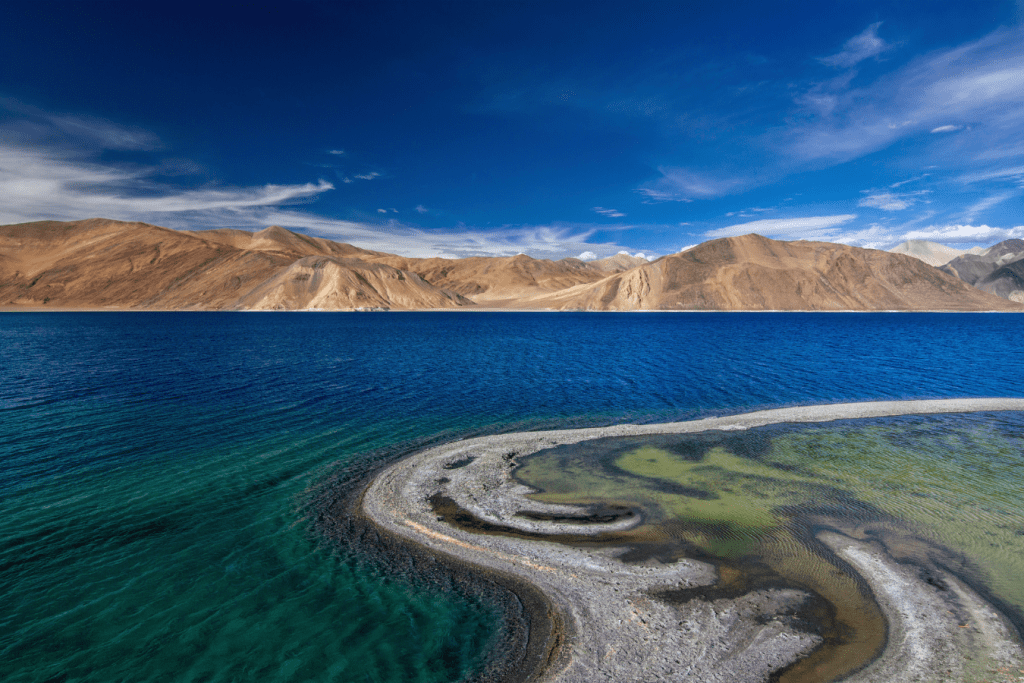
So, why does this happen?
It’s because of a few natural reasons. The lake is full of minerals, it’s located at a very high altitude, and the air is very clean in Ladakh. All these things together allow sunlight to reflect off the water in different ways. Also, the weather and time of day change how the lake looks.
For example, during the morning the lake might be dark blue, but then by afternoon it becomes green or light blue. Whether the sky is sunny or cloudy also affects the color. During sunset, the lake can even look pink or orange because of the light.
Both travelers and photographers love this amazing feature of Pangong. It feels like the lake is showing its mood, and in a way, it matches yours too. Watching the colors change is like seeing a beautiful painting that’s always moving.
The Best Time for You to Visit Pangong Lake
May to September is considered the ideal travel season:
- Roads are accessible
- Day temperatures range from 5°C to 20°C
- Camps, homestays, and tourist services are operational
Winter (November to March) is extremely harsh:
- Temperatures drop below -20°C
- The lake completely freezes
- Access is limited due to snowfall and closures
Recommended months for photographers: June and September, for clear skies and vibrant lake colors.
What Makes Pangong Lake Unique?
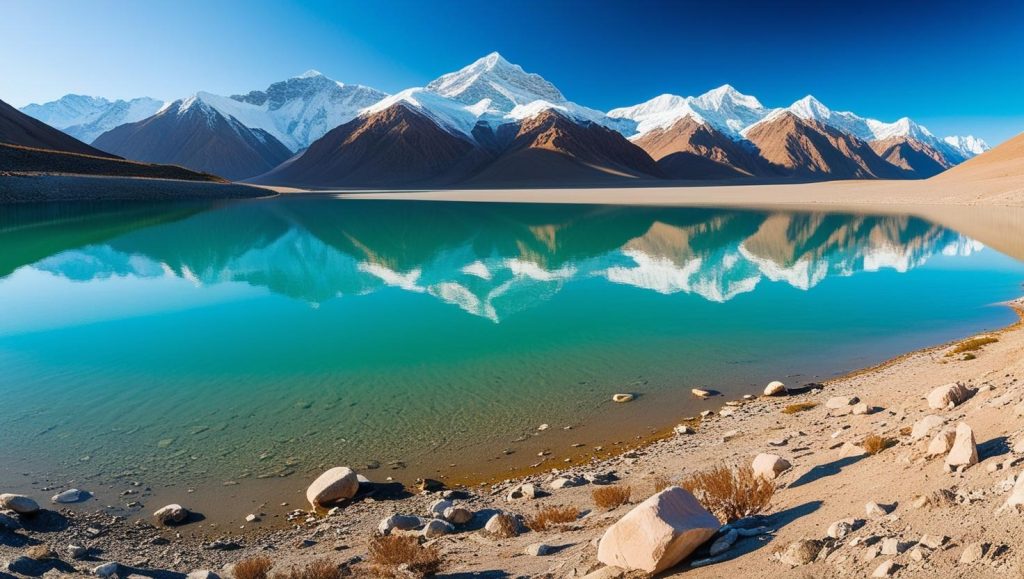
- One of the highest saltwater lakes in the world that freezes completely during winter
- A potential Ramsar Wetland Site, recognized for its ecological significance
- No fish or aquatic life due to salinity, but an important breeding site for migratory birds
- Featured in several Indian films, adding to its cultural and cinematic recognition
It’s a place where geology, ecology, and spirituality intersect—unlike any other destination in India.
Top 5 Unforgettable Things for You to Do at Pangong Lake
1. Spot the Rare Himalayan Marmots
As you drive to Pangong Lake, about 25 kilometers before you reach the lake, you will see signs that tell you to stop and look for Himalayan marmots.
These marmots are small, fat, and furry animals that live in the ground. They make holes called burrows and often come out to sit in the sun. If you wait quietly, you can see them standing up or running around. They are very cute and fun to watch.
These animals live only in high mountains, so seeing them here is something special. You can also take nice photos if you’re patient.
So, when you see the sign, stop for a little while. You might get lucky and see these friendly little mountain animals!
2. Watch Beautiful Migratory Birds Fly
During the summer, Pangong Lake becomes home to many beautiful birds that fly from faraway places. These are called migratory birds because they travel long distances to find the right weather.
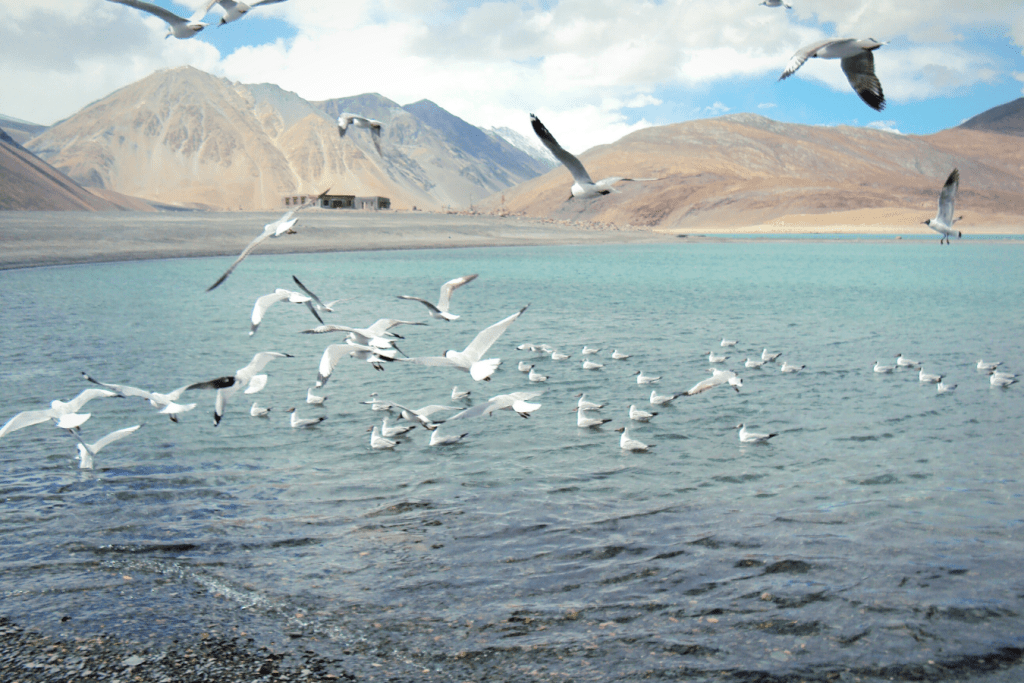
Some of the birds you might see are:
- Bar-headed geese
- Brahminy ducks (also called ruddy shelducks)
- Brown-headed gulls
These birds come to nest and rest along the lake’s quiet shores. If you enjoy watching birds or taking photos, this is the perfect place for you. The peaceful lake, blue sky, and flying birds create a magical and calming scene.
So, whether you’re a bird lover or just someone who enjoys nature, don’t forget to look up—you might spot some amazing birds flying right over the lake.
3. Stay in a Camp Near the Lake
If you want to enjoy Pangong Lake even more, you can stay in a camp right next to the water. There are many camps where you can spend the night, such as:
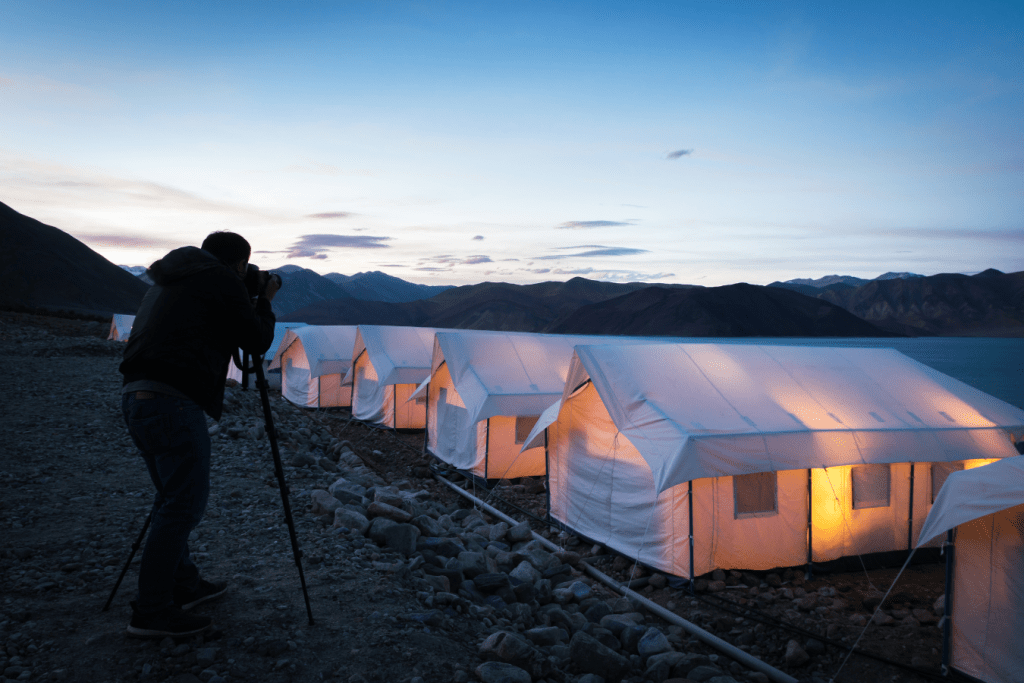
- Watermark Camp
- The Nature’s Nest
- Camp Whispering Waves
These camps are simple but comfortable. They give you a cozy tent, warm local food, and a chance to relax close to nature.
At night, the sky becomes very clear, and you can see thousands of stars. It’s a great place for stargazing or even taking photos of the stars if you enjoy photography.
Staying in a camp like this is a special way to feel the peace and beauty of Pangong Lake, both during the day and at night.
4. Explore Villages Near the Lake
While visiting Pangong Lake, you can also take some time to see nearby villages in Ladakh. These small places show you how people live in the high mountains of Ladakh. Each village has something special to share:
- Spangmik Village – This is the closest village to the lake. The people are very friendly, and you can see how they live in such a peaceful and remote place.
- Tangtse – A tiny village at a high altitude. It’s known for its military importance and beautiful natural views.
- Chushul – This village is known for its history. It has memorials that tell the story of the 1962 Indo-China war.
All of these villages give you a chance to see real Ladakhi culture, learn how people live in extreme weather, and feel the strong spirit of the local communities.
5. Meditate by the Lake
Pangong Lake is one of the quietest and calmest places you’ll ever visit. There’s a special kind of silence here—peaceful and powerful.
You can simply sit by the water, watch the light change on the mountains and lake, and let your mind relax. The beauty and stillness of the place help you feel calm and clear inside.
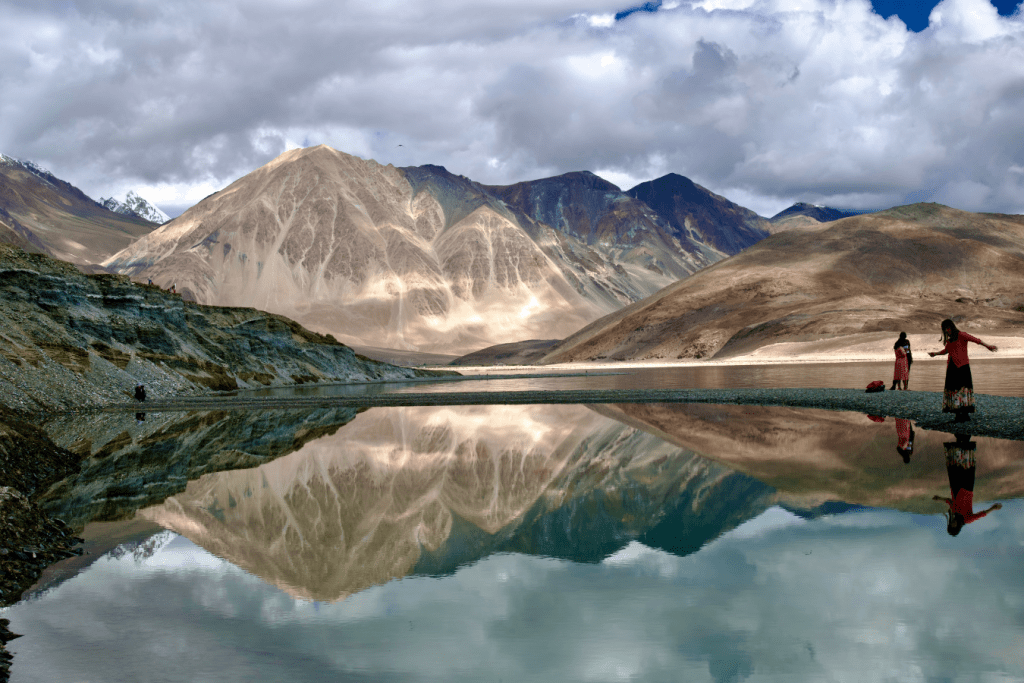
It’s the perfect spot to take a deep breath, think quietly, or just enjoy the moment. If you ever wanted a place to feel truly peaceful, this is it.
Travel Tips for You: Be Smart, Be Safe
- Acclimatize in Leh for at least 48 hours before heading to Pangong to avoid altitude sickness
- Carry layered clothing, even in summer, due to temperature swings
- Mobile networks are limited; BSNL has minimal coverage in some areas
- Avoid boating or swimming—the water is dangerously cold and deep
- Be a responsible traveler: carry reusable water bottles and avoid littering
How to Reach Pangong Lake
By Road from Leh (160 km)
The most common route is via Chang La Pass, the third-highest motorable road in the world. The journey takes 5–6 hours and offers incredible views, though the road conditions can be challenging.
Permit Requirements
- Indian citizens need an Inner Line Permit (ILP)
- Foreign nationals require a Protected Area Permit (PAP)
These are easily obtainable from the Leh DC office or online.
Conclusion
In the end, Pangong Lake is not just a place you visit—it’s a place you feel in Ladakh. From its ever-changing colors to its peaceful silence, from rare wildlife to simple village life, every moment here is special. Whether you’re watching birds fly across the sky, camping under the stars, or just sitting quietly by the water, the lake gives you memories that stay in your heart.
So, if you’re planning a trip to Ladakh, don’t miss Pangong Lake. It’s more than just a beautiful spot—it’s a chance to connect with nature, history, and yourself. Also, the journey to get there—through high mountain passes and quiet valleys—adds to the magic.
In short, Pangong Lake is a dream destination. Both peaceful and powerful, it welcomes every kind of traveler.